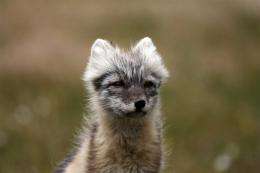An Arctic Fox near Kangerlussuaq, Greenland. Polar bear cubs, the Arctic fox and caribou herds are among the victims of dramatic changes in the Arctic due to climate change. Almost 10 percent of the world's mammals, birds, reptiles, amphibians and fish are in danger of extinction due to climate change and other factors, according to an Australian report released Tuesday.
Almost 10 percent of the world's mammals, birds, reptiles, amphibians and fish are in danger of extinction due to climate change and other factors, according to an Australian report released Tuesday.
The "Number of Living Species in Australia and the World" study found 0.9 percent of the world's 1.9 million classified species were at threat, including 9.2 percent of major vertebrate species.
Australia's government-funded Biological Resources Study, the world's only census of animal and plant life, found 20.8 percent of mammals were endangered, as were 12.2 percent of birds and 29.2 percent of amphibians.
Of reptiles, 4.8 percent were considered threatened, along with 4.1 percent of fish species.
"In Australia and around the world, biodiversity is under huge and growing pressure," said environment department secretary Robyn Kruk.
"The pressures are pervasive and chronic in many places; invasive species, habitat loss and climate change in particular."
Australia was found to be home to 7.8 percent of the world's known species. Environment Minister Peter Garrett said the study had shown its wildlife was highly unique, with 87 percent of mammals and 93 percent of reptiles found nowhere else in the world.
However, the study also showed Australian species accounted for 9.1 percent of the world's threatened flora and fauna, and Garrett said vigilance was essential.
"We have a long way to go, we have discovered and named only about a quarter of Australia's estimated number of flora and fauna," said Garrett.
"We need this essential information to do a better job of managing our biodiversity against the threats of invasive species, habitat-loss and climate change."
According to the report there were likely to be some 11 million species on Earth of which only 1.9 million had been discovered, with millions of invertebrates, fungi and other organisms yet to be found and named.
(c) 2009 AFP




















